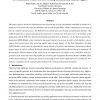Free Online Productivity Tools
i2Speak
i2Symbol
i2OCR
iTex2Img
iWeb2Print
iWeb2Shot
i2Type
iPdf2Split
iPdf2Merge
i2Bopomofo
i2Arabic
i2Style
i2Image
i2PDF
iLatex2Rtf
Sci2ools
102
click to vote
DSN
2004
IEEE
2004
IEEE
An Architectural Framework for Providing Reliability and Security Support
This paper explores hardware-implemented error-detection and security mechanisms embedded as modules in a hardware-level framework called the Reliability and Security Engine (RSE), which is implemented as an integral part of a modern microprocessor. The RSE interacts with the processor through an input/output interface. The CHECK instruction, a special extension of the instruction set architecture of the processor is the interface of the application with the RSE. The detection mechanisms described here in detail are: (1) the Memory Layout Randomization (MLR) Module, which randomizes the memory layout of a process in order to foil attackers who assume a fixed system layout, thus protecting against many security threats, (2) the Data Dependency Tracking (DDT) Module, which tracks the dependencies among threads of a process and maintains checkpoints of shared memory pages in order to rollback the threads when an offending (potentially malicious) thread is terminated, (3) the Instruction ...
Computer Networks | DSN 2004 | Instruction Set Architecture | Memory Layout | Memory Layout Randomization |
Related Content
| Added | 20 Aug 2010 |
| Updated | 20 Aug 2010 |
| Type | Conference |
| Year | 2004 |
| Where | DSN |
| Authors | Nithin Nakka, Zbigniew Kalbarczyk, Ravishankar K. Iyer, Jun Xu |
Comments (0)

